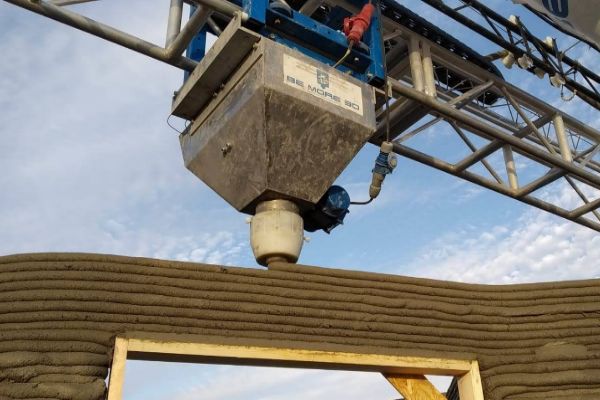Someday, all the houses will leave a printer and the construction process, instead of taking months, will only take a few hours. That is the future for which the Valencian Be-3D start-up now works, emerging from the entrepreneurial ecosystem of the Polytechnic University of Valencia (UPV).
His team has developed a 3D printer capable of pouring layers of reinforced concrete following a predetermined path and that, once solidified, form firm and solid walls.
"For people to understand, I usually say that it is like a pastry bag, but of concrete," explains José Guillermo Muñoz , one of the building engineers behind this project. "A code that we have developed is also introduced to the machine, and that marks the path through which the concrete is deposited. And the printer throws successive layers that ultimately create a volume."
A year ago, the company tested its technology by building the first house built on-site in Spain on the UPV site with a 3D printer, which now functions as a "pilot floor". Recently, he has participated in the Solar Decathlon Africa contest, held at the Green Energy Park in Marrakech, in Morocco, where he has built another house of 21 square meters in 12 hours.
"This is an architectural competition in which students from different universities design a house and build it there," says Muñoz. "Then these homes are tested on issues of efficiency and habitability, among other things. We were invited to make a house as a demonstration, without participating in the contest. Once finished, they will become a village for students of that polytechnic university. "
The main advantages of this technology are cost savings and, above all, time. "Depending on the square meters, it takes between 8 and 12 hours to finalize the structure of a house, although then it has to be finished by traditional methods," says José Guillermo Muñoz. "In the case of social housing, with very large promotions, practically one house can be generated per day. The printer works on wheels and can move and print one after another."
Another possible use, he adds, would be in situations of natural disasters , to build emergency homes stronger than the usual tents. "As you are doing something provisional, you can build smaller houses faster, at the rate of two or three a day. But being concrete, a much more durable material, those shelters will be more habitable," says the engineer.
The investment required by this printer is "important" although it is, "in line with the prices of the sector," according to Muñoz. However, he points out, "the profitability that can be obtained is greater. We are in contact with different construction companies worldwide and what they are interested in is to use it to manufacture homes with the shapes they want. And the machine does not care to make a curve, a corner or a straight wall. The cost does not increase because the house has an unusual shape, as we see in the one we built in Morocco. "
Beyond the homes themselves, the 3D printers of this Valencian start-up have utility in civil works. "A machine is used to generate all kinds of prefabricated in situ: beams of bridges, railings, etc ...", he says.
Be More 3D works within the UPV, although independently, and collaborates with the institution in the development of materials and new construction systems. "We work with professors José Ramón Albiol and José Luis Alapont , and also with a series of students with concerns about new technologies that prepare all designs and are developing the program that the printer works with," Muñoz explains.
Now, the most immediate for them is the project to build a house in Manacor, in Mallorca: "We are waiting for the building license. If it goes ahead, it will be the first house that will be made for a client and that they can live in it" . In addition, he adds, they continue research to refine and expand the uses of technology. "Our next objective is a multi-floor printer and we are also developing greener materials that have the same durability properties as concrete," says José Guillermo Muñoz.
In his opinion, "the future of construction will go through 3D. It will be in any work, with machines that build houses and others that produce prefabricated structures. In Europe it is already considered a key technology and, right now, I can not nor begin to imagine how far he will be able to go. "
According to the criteria of The Trust Project
Know more- Morocco
- Europe
- Spain
- Africa
- Valencia
- Valencian Community
Interior 29 people arrested for trafficking in human beings and abducting minors from protection centers
Macroeconomics Spain calls for compensation measures in Brussels if the US imposes tariffs on oil, olives or wine
Courts The Supreme repeals the condemnation of Spain for not accepting refugees agreed with the EU

